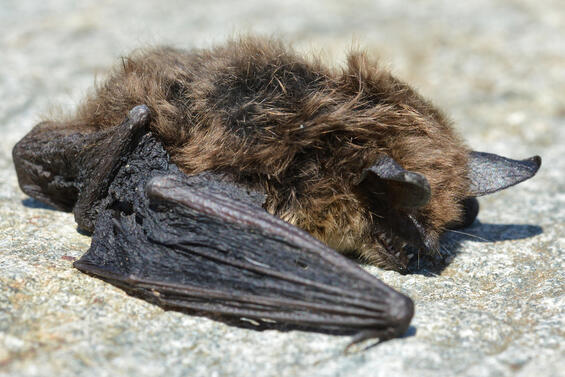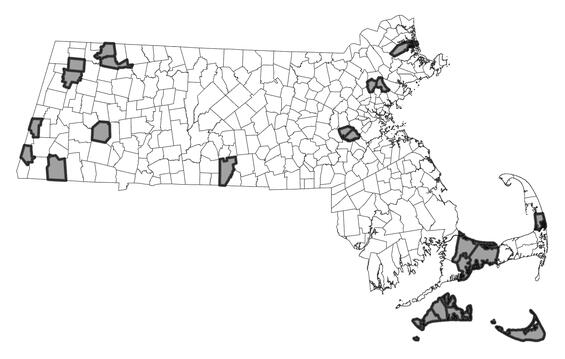- Scientific name: Myotis septentrionalis
- Species of Greatest Conservation Need (MA State Wildlife Action Plan)
- Endangered (MA Endangered Species Act)
- Endangered (US Endangered Species Act)
Description

Northern long-eared bat (Myotis septentrionalis)
The northern long-eared bat is a small bat with large ears, which when pushed forward extend at least 4 mm (0.16 in) past its nose. Its fur and wing membranes are light brown, giving it an overall somewhat uniform brown appearance. The hairs on its back are bicolored, with a dark base and lighter tip. The northern long-eared bat averages 50-95 mm (2-3.75 in) in total length, with a tail of 35-42 mm (1.4-1.6 in). The forearm is 32-37 mm (1.3-1.5 in). In weight, it averages 5-8 g (0.2-0.3 oz). This bat is typically found roosting in trees and feeding in forested habitats but may occasionally be found in human habitations.
Similar species: The best diagnostic character to distinguish the northern long-eared bat from other species in Massachusetts is its long ears. The rare little brown bat (Myotis lucifugus, endangered) and Indiana bat (Myotis sodalis, endangered, federally endangered) are similar in appearance, but have shorter ears, which typically do not extend beyond their nose when pushed forward. The tragus, which is a fleshy projection which sticks up in front of the ear opening, is long and narrowly pointed in the northern long-eared bat, while it is shorter and blunt in the little brown bat. The little brown bat also has glossier fur and a shorter tail relative to its body length. The Indiana bat has a keeled calcar (a ridge of cartilage along the edge of the membrane between the foot and the tail), which the northern long-eared bat lacks. Other features of interest in identification include the bat’s hairless interfemoral membrane (the skin stretching between the legs and tail) and lack of a black face mask (which is characteristic of eastern small-footed bat, Myotis leibii, endangered).
Life cycle and behavior
In the summer months, northern long-eared bats emerge at dusk from daytime roosts for the first in a series of feeding flights. Their long tails and large wing membranes allow the bats to fly slowly and navigate through cluttered environments. These special adaptations also enable them to glean prey from foliage, in addition to catching insects on the fly. These bats locate resting insects through a combination of passive listening and the emission of high frequency echolocation calls.
Between August and October, the body weight of northern long-eared bats increases by up to 45%, as they store fat for winter. In late summer, the bats begin to “swarm” around the entrances of caves and are thought to be testing the air of possible hibernacula. This is the time when mating occurs, with females storing the sperm within their bodies until spring. By early November, the bats enter hibernation sites. Their metabolisms slow and they enter torpor but will rouse occasionally throughout the winter to drink water. Northern long-eared bats share caves with a number of other species but tend to hibernate singly or in small groups in deep cracks or crevices. They return to the same hibernacula in multiple years but may not hibernate in the same location every year. Little data are available on migration, but the bats are known to travel up to 56 km (35 mi) from foraging sites to winter hibernacula.
Females bear and rear single young from mid-May through July. The longevity record for the northern long-eared bat is 18 years.

Population status
As a result of the sudden and catastrophic mortality caused by white-nose syndrome, the northern long-eared bat is listed as endangered under the Massachusetts Endangered Species Act.
Distribution and abundance
The northern long-eared bat is found across forested parts of the eastern United States and Canada, west to British Columbia, Wyoming, and Montana, and south into Florida. It was historically common in New England, the Canadian Maritimes, Quebec and Ontario, and uncommon in the western extremes of its range.
In Massachusetts, northern long-eared bats occur statewide and have been identified in 99 of 351 municipalities in 11 of 14 counties.

Distribution in Massachusetts, 1999-2024 based on records in the Natural Heritage Database.
Habitat
In the warmer months, colonies of northern long-eared bats may be found roosting and foraging in forested areas. Preferred roosts are in clustered stands of large trees, especially in live or dead hardwoods with large, tall cavities. These bats are found in other types of tree roosts as well, and occasionally in human-made structures. Northern long-eared bats forage under the forest canopy in structurally complex habitats, often above small ponds, vernal pools or streams, along gravel paths or roads, and at the forest edge. In winter, northern long-eared bats hibernate in natural caves and abandoned mines, preferring habitats where the humidity is so high that water droplets sometimes cover their fur. Large winter hibernacula (hibernation sites) have been reported in Berkshire, Franklin, Hampden, Middlesex, and Worcester counties. The spread of the white-nose syndrome fungus initially eliminated all northern long-eared bats from the traditional mine and cave hibernacula. The first to re-appear was seen in the winter of 2023/24. In the years after they disappeared from the large hibernacula, small numbers of individuals were found outside of two timber rattlesnake den sites, in a street storm drain system and in earthen basements and crawl spaces of houses in Barnstable, Dukes, Middlesex and Nantucket counties.
Healthy habitats are vital for supporting native wildlife and plants. Explore habitats and learn about conservation and restoration in Massachusetts.
Threats
Once a common species in the northern United States, populations of the northern long-eared bats have been devastated by the spread of white-nose syndrome. Populations in infected hibernacula in the Northeast have suffered catastrophic losses of 90-100%. White-nose syndrome is caused by a newly described fungus, Pseudogymnoascus destructans, which is believed to be a non-native species accidentally introduced from caves in western Europe. European species of bats have co-evolved with this fungus, so they have a high degree of immunity. The fungus grows over bats while they hibernate, causing them to rouse from dormancy frequently, lose valuable stored fat, and fail to survive the winter. The fungus is believed to be passed from cave to cave primarily by the movements of breeding male bats, but human transport is also thought to be responsible for the infection of some hibernacula. Summer habitat availability is not a limiting factor in Massachusetts.
Conservation

Northern long-eared bat (Myotis septentrionalis)
The U.S. Fish & Wildlife Service is working in concert with government and non-profit groups to understand the spread of the fungus and potential for stopping its spread. Access to suitable undisturbed hibernacula is essential to the survival of the northern long-eared bat, and protection of known sites is paramount. Human disturbance of hibernacula can be discouraged or prevented with the use of gated entrances, to avoid arousal of hibernating bats and the spread of fungal spores.
All listed species are protected from killing, collecting, possessing, or sale and from activities that would destroy habitat and thus directly or indirectly cause mortality or disrupt critical behaviors. In addition, listed animals are specifically protected from activities that disrupt nesting, breeding, feeding, or migration.
References
Caceres, M.C., and R.M. Barclay. 2000. Myotis septentrionalis. Mammalian Species 634: 1-4.
MassWildlife. 2020. Homeowner’s Guide to Bats. Massachusetts Department of Fisheries & Wildlife: Westborough, MA. 26 pp.
U.S. Fish & Wildlife Service. 2012. “White-nose Syndrome.”
Whitaker, J.O., Jr. and W.J. Hamilton, Jr. 1998. Mammals of the Eastern United States, Third Edition. Cornell University Press, Ithaca, NY. 583 pp.
Contact
| Date published: | March 4, 2025 |
|---|